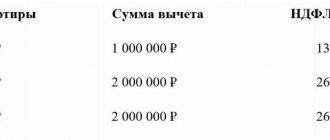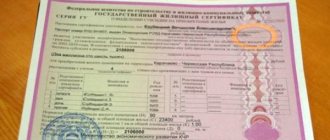The transfer of cash from one person to another must be accompanied by the preparation of a special receipt. Most often, this document is used in relations between individuals, but sometimes it can also be used between ordinary citizens and organizations (for example, when it comes to banks or microfinance companies).
- Form and sample
- Free download
- Online viewing
- Expert tested
FILES
Why do you need a receipt?
A receipt is a document that confirms that money was transferred from one individual or legal entity to another person as a loan or for other reasons.
The receipt contains information about how much money was given, under what conditions, and in what period it should be returned to the lender.
In cases where disagreements arise between the creditor and the debtor and one of them decides to go to court, it is the receipt that becomes the official document that proves the fact of the transfer of money, and also shows the conditions for their use and the time frame within which they should have been received given back.
A receipt is not one of the mandatory documents that must accompany the transfer of cash (by the way, in relations between citizens there are no such documents at all), but it is recommended.
Preparation of procedural documents
In order not to face a refusal to collect a debt on a receipt, you must prepare the documents correctly. You must submit to the court:
- Statement of claim in two copies - the second is sent to the debtor.
- Receipt for payment of state duty.
- Documentary evidence of debt: promissory notes, loan agreements, account statements, a copy of the claim, bank transfers and postal notices.
The key emphasis is on the statement. This is the document that is considered first. How to file a claim?
The statement of claim must include:
- We indicate the full names of the parties, passport details, residential addresses, and contacts.
- We indicate the name of the court to which we are applying.
- In the text of the application we list the violations - delays, lack of payment with references to legislative norms.
- We list the circumstances that arose within the framework of relations with the debtor.
- We provide a detailed calculation of the requirements - the principal amount of debt, accrued interest and remuneration for unauthorized use of loan money.
- We confirm that the claim procedure has been followed.
- We list the contents of the attached package of documents.
You must go to court within the period strictly BEFORE the expiration of three years from the moment the delay arose. This is the statute of limitations for debts. If you miss the deadline, the debtor will be able to send a counter-statement - and it will no longer be possible to receive your money on the receipt; the court will close the case based on the debtor’s appeal.
When is the document most often used?
There are many reasons for creating a receipt for receiving funds:
- purchase and sale of goods;
- payment for services or rent;
- simple debt, etc.
It should be noted that in a situation where we are talking about a debt obligation, the parties sometimes enter into a loan agreement between themselves - it is more serious from the point of view of the law, because contains more complete and detailed information, but must be drawn up according to a certain scheme and structure, while a receipt is simpler in terms of design and at the same time has almost equal legal force (provided, of course, that it contains some mandatory information).
Changing statutes of limitations
As a general rule, the limitation period begins from the day when the creditor's rights were violated and ends three years later. However, due to various circumstances, the law provides for the possibility of extending, suspending and reinstating the statute of limitations.
Suspension
The following circumstances serve as legal grounds for suspending the limitation period:
- the parties, by concluding an additional agreement, extended the period for fulfilling debt obligations;
- there have been changes in the current legislation, due to which the document on the basis of which the legal relationship between the parties to the loan agreement arose has lost its legal force, and the parties cannot refer to it in the future;
- departure of one of the parties to the transaction to the place of military service;
- a moratorium has been introduced at the legislative level, which does not allow the parties to fulfill their obligations;
- the occurrence of force majeure in the form of natural disasters recognized as insurmountable, which do not depend on the actions and will of the borrower.
Do I need to get it certified by a notary?
The obligation to certify a receipt by a notary is not stipulated in the legislation of the Russian Federation, i.e. Each lender has the right to decide for himself whether he is interested in having the receipt certified by the signature of an employee of a notary office or not.
However, the very fact of having a notary’s autograph gives the receipt greater significance, so you should not neglect it.
The only minus here, or rather, even two – time costs and additional financial expenses.
What to do if the statute of limitations has expired
Attention! The norms of current legislation, in particular Part 1 of Art. 199 of the Civil Code, oblige the court to accept the claim for consideration, regardless of whether it is filed within the limitation period or after its expiration.
This approach is explained by the fact that the requirement to apply the limitation period can be stated by the party participating in the case. On its own initiative, the court has no right to apply the limitation period.
This is directly stated in Part 2 of the above article: “The limitation period is applied by the court only upon the application of a party to the dispute made before the court makes a decision.”
Thus, only the defendant or his legal representative can exercise the granted right and petition the court for the need to apply a statute of limitations when considering a specific dispute between the parties. Such a statement can be made only until the court announces its decision in the case.
As practice shows, there are often cases when, after the expiration of the statute of limitations, the debtor partially fulfills his obligations under the loan and returns the money. In this case, the provisions of Article 203 of the Civil Code apply.
If the debtor has taken actions confirming the fulfillment of the obligations assumed, that is, has actually acknowledged the existence of the debt, then the statute of limitations is interrupted and its course begins anew. In this case, the time that passed before the start of fulfillment of obligations is not counted in the total limitation period.
Why are witnesses needed?
Some lenders prudently enlist the support of witnesses when transferring money. They may be uninterested persons, information about whom is also required to be included in the receipt (their full name, passport details and address of residence).
With their signatures, they confirm the fact that the money was transferred exactly in the amount stated in the receipt and on the conditions indicated in it.
In fact, in some way the witnesses perform the function of a notary.
If the receipt does not indicate a deadline
Depending on the relationship between the lender and the borrower, as well as on a number of other factors, the loan repayment period may not be agreed upon. That is, there is no indication by what time the borrower must repay his debt to the lender.
The law on this state of affairs states that the creditor can at any time make a demand for repayment of the debt. This is directly stated in paragraph 2 of Art. 200 GK. Thus, the limitation period will be calculated from the date when the creditor presents a written demand to the borrower to repay the debt.
The receipt may also indicate a “grace” period. That is, borrowed funds are provided for a specific period. After its expiration, the borrower becomes obligated to repay it, and the creditor has the right to demand fulfillment of obligations by the debtor.
Attention! Our qualified lawyers will assist you free of charge and around the clock on any issues. Find out more here.
Rules for drawing up receipts
This document is formed in simple written form in any form on a regular sheet of paper. It is also possible to print the receipt on a computer, but this option is not considered the best, since if there is a need for a graphological or handwriting examination, such a receipt will not be the most convenient object of study.
The text must indicate:
- date and place of document formation;
- last name, first name and patronymic of the person who takes the money, his passport details, address of residence (official and actual). Similarly, the receipt contains information about who gives the money;
- amount - it must be indicated in numbers and words;
- if cash is transferred in foreign currency, we advise you to indicate its current exchange rate and the amount in which the debt will need to be repaid;
- deadline for refund;
- return method: cash or by bank transfer - to a card or bank account) and return method - lump sum or in installments. If the second option is chosen, you need to draw up a detailed payment schedule;
- in the case where money was given, what is called “at interest,” this must also be indicated in the document (and the amount of the interest rate must be specified).
Finally, the receipt must be certified by the signature of the person who accepts the money (it is desirable that the signature matches the one in his passport) and the autographs of witnesses, if any, during the money transfer procedure. If desired, the lender can also sign the document.
The receipt is drawn up in a single copy and handed over to the lender.
How to repay a debt using a receipt
The process of collecting a debt from an individual against a receipt has its own peculiarities. It is important to know when and how a person can claim their rights.
When can you demand money?
According to current legislation, the creditor has the right to sue the debtor from the moment of violation of debt obligations. Depending on what conditions are specified in the receipt, the requirement appears:
- from the day following the date of return of the full amount;
- from the day following the date of repayment of half of the loan, if there is an agreement between the parties to pay in installments;
- after the borrower refused to repay the debt within a reasonable time, when the receipt does not indicate the exact date of repayment.
The last point is a special case. If, at the time of drawing up the document, the parties have not agreed on the exact date when the debtor is obliged to return the money, the transaction is considered to be concluded for an indefinite time. In practice, the lender must first send a request for repayment to the borrower in writing, and then take more radical actions within a reasonable period of time (in the most common practice, this is about 30 days).
Pre-trial settlement, filing of formal claims
If the debtor categorically refuses to fulfill his obligations, lawyers who work to collect debts by receipt recommend not wasting time and immediately filing papers with the court.
In other cases, you can try to resort to pre-trial settlement of the problem. During this, the following actions are performed:
- A couple of days before the date when the debt is due to be repaid, you need to remind the borrower about this. You can do this by sending a message to your phone or on a social network. Based on the person's response, it can be concluded whether he intends to fulfill his obligations or not.
- A written notice or claim is sent when the return period has passed. It is better to do this by registered mail with a notification by mail or hand it in person so that the person signs for receipt.
- If this is acceptable, you can discuss with the debtor the option of extending the repayment period. They do this only in cases where there is confidence that the person will return the funds soon.
Obtaining a notary's writ of execution
This method has been used relatively recently; it has been introduced since 2018. Any lawyer for debt collection by receipt will suggest starting with it if the document was drawn up with the assistance of a notary.
Debt collection occurs as follows:
- the creditor goes to the notary, who makes a writ of execution on the promissory note;
- the receipt is transferred to the FSSP (without legal proceedings).
A document with a notary's writ of execution is already a reason for starting enforcement proceedings. But you will still need to fill out an additional application in order for it to be opened. It also indicates the bank account for depositing funds.
At the next stage, bailiffs do everything to ensure that the creditor gets the money back.
Contacting third parties to draw up an agreement for the assignment of the right of claim or enforcement
The Civil Code of the Russian Federation provides for the possibility of assignment of debt claims by the borrower to a third party. Such relationships must also be formalized in writing. This option is used when a third party is able to help in repaying the debt against a receipt.
The agreement implies the transfer by the present creditor of the rights to the debt to another person for a certain fee. As soon as the agreement is concluded, a third party has the right to collect the money.
The debt of individuals can be sold both before the trial and after (when there is a writ of execution in hand). The assignment agreement is concluded without the consent of the debtor, but he must be notified.
Preparation of documents for going to court
Having a receipt in hand, you can safely go to court. To do this, you need to draw up a statement of claim and attach to it a copy of the document confirming the loan of money. The original receipt will need to be presented directly at the court hearing. In addition, you need to prepare the following documents:
- calculation of the amount required for the claim;
- copies of written demands addressed to the debtor;
- responses to demands from the borrower;
- other correspondence with the debtor;
- receipt for payment of state duty.
A lawyer or lawyer who specializes in collecting debts by receipt can provide full advice on the procedure for filing documents for the court.
When can you get a court order?
The current legislation provides for the possibility of obtaining a court order. This procedure takes from two weeks to a month. An order is received if the amount of debt is no more than 500 thousand rubles. Also in this case, a receipt is required.
As part of the issuance of a court order, the court considers the case without summoning the parties and issues a court order. A copy of the order is sent to the borrower, who can challenge it within 10 days. If the person does not do this, the court order comes into force and is sent to the FSSP. Next, enforcement proceedings are opened.
How to draw up a statement of claim and submit documents to court
If there is a need to collect a debt from a person on a receipt, it is more effective to do this through the court. However, this path will take a lot of time.
First you need to find out the jurisdiction of the case. If the debt is no more than 50 thousand rubles, they go to the magistrate, when more - to the district court. In both the first and second cases, you need to go to the authority at the place of registration of the borrower.
Claim proceedings involve several stages.
At the first stage, a claim is drawn up. Next, the paper is sent by mail to the debtor. During the trial, this document acts as an argument in favor of the plaintiff. The claim indicates that the creditor tried to resolve the dispute out of court.
The second stage involves filing a claim. The document is drawn up in free form, but it must contain the following information:
- address and name of the judicial authority;
- Full name, address of registration and other information of the plaintiff and defendant in the case;
- statement of the plaintiff's position;
- the total amount of the payment (includes the principal debt, possible interest, state duty, penalty, expenses for a lawyer, etc.);
- evidence and facts;
- signature.
Next, the person pays the state fee and sends a package of documents to the court.
At the next stage, the actual court hearing takes place. By the way, there may be several of them. Some cases are considered for more than one month. The duration depends on the circumstances of the case.
The collection of debt against receipt through the court ends with the issuance of a writ of execution. After the court makes a decision, it is issued 30 days later.
We won the trial, what to do next?
Unfortunately, receiving a writ of execution or court order does not guarantee that the creditor will immediately receive the money. With rare exceptions, debtors return funds voluntarily and promptly. As a rule, if help is needed in repaying a debt under a receipt, plaintiffs are forced to go to bailiffs to speed up the process.
Having a writ of execution or a court order in hand, you can go:
- to the bank to write off debt from the defendant’s personal account;
- for the borrower’s work, so that the required amount is withheld from his salary (if the debt is less than 100 thousand rubles);
- to the FSSP so that the bailiffs can take care of the debtor.
FSSP employees have the right to send papers to withhold funds at the defendant’s place of work or to a financial institution in order to repay the debt. However, besides this, they have many other powers. For example, they can make it so that until the debtor returns the money, he will not be able to leave the country.
How to transfer money correctly?
Lending is always a risk. And here you will never guess: both friends and relatives - everyone can change in an instant and go into denial. To protect yourself from non-returns, keep the following guidelines in mind:
- Always check the borrower’s passport: look at the photo. Check the data in the Ministry of Internal Affairs databases;
- Please write the receipt by hand. This is important because graphical expertise may be required in the future;
- Do not forget to familiarize the debtor with the rules for issuing promissory notes;
- Take the original promissory note for yourself;
- Remember that you cannot take any documents as collateral. This will result in criminal liability.
Remember that the terms of the promissory note are dictated by the lender. It is he who must determine the date of return of the money and the interest rate. If you do not specify the deadline for repaying the debt, it will be considered indefinite - in order to hurry the borrower, you will need to send notifications. If you do not indicate the percentage for using money, then in the future you will be able to count on the rate of the Central Bank of the Russian Federation. And this is not profitable.
Legal force of a receipt for receiving money
Fearing getting into trouble in our difficult times, many are beginning to wonder what a correctly drawn up receipt is and what document has legal force, what should be included in the paper, and most importantly, what you can count on when you have it in your hands. Let's figure it out together to reliably protect your money from attacks by unscrupulous borrowers, and just keep abreast of all events. First of all, a receipt is a bill of exchange, that is, a real document that indicates the transfer of a certain amount of money from one person to another, with a guarantee of return under specific conditions if they are mentioned in the body of the receipt.
Important
You should know that a receipt that is not certified by a notary has legal force and can be used to collect a debt only if the amount of borrowed funds exceeds ten minimum wages accepted at the time of its preparation.
When understanding the power of a receipt that is not certified by a notary, it is worth turning to the legislation, since only there you can get clear and reliable information on such issues. According to domestic law, namely Articles 163 and 164 of the Civil Code of the Russian Federation, it is not necessary to notarize transactions if they are not subject to mandatory registration at the state level (real estate, land, securities, minerals, metals, etc.).
At the same time, a receipt will be useful to confirm the transfer of money. The law even allows for an oral agreement, but only if the loan amount does not exceed ten thousand rubles. If the amount is higher, it makes sense to protect yourself and your funds and take a handwritten receipt. If a loan agreement is concluded, according to Law 808 of the Civil Code of the Russian Federation, it makes sense to have the paper certified by a specialist who has the right to do so (a notary).
Sometimes this paper can be written not only regarding financial assets, but also other valuables, for example, a list of things when renting an apartment will also be considered a full receipt. Therefore, to the question of whether a handwritten receipt has legal force, there is a very specific answer, of course, it is positive. Moreover, written by the debtor himself, and not printed on a computer, this paper will help prove in court his attitude towards the borrowed funds.
What if the debtor is not going to repay me?
A receipt is a document that implies the repayment of a monetary debt by a certain date. It confirms the fact of transfer of funds. If the debtor refuses to voluntarily fulfill his obligations, this piece of paper will help defend his rights in court. The most important thing is that the receipt is drawn up correctly. With this agreement, you will be able to file a claim that will help restore justice.
Keep in mind that a receipt is enough to protect yourself in court. It confirms the existence of a monetary debt. The creditor will only need to pay a fee, which he can apply to a higher authority. They will start a trial there. The bailiffs will study the case and schedule a trial. Usually the debtor immediately admits the debt and explains why he cannot pay his obligations on time. The fact of the loan is recognized if he does not appear in court within 1-2 months.
But there are situations when debtors try to deny the fact of transfer of money. He disputes the receipt and points out that there was no transfer of money. This is especially easy to prove if errors were made in the receipt: the date, amount, percentage, and borrower’s information were incorrectly written. The presence of such an error may cause the document to be canceled - the legal process will drag on for a long time. A graphical examination will be required to prepare evidence. Witnesses may be required who can confirm the transfer of money.
Keep in mind that a positive outcome of the trial does not mean a refund. Very rarely do debtors pay off their debts quickly. Lenders have to turn to bailiffs: they describe the property, write off funds from the account, and withhold from salaries. You can submit a writ of execution to the borrower’s place of work or to the bank. It is best to contact the FSSP: employees will not only withhold payments from your salary, but will also create a ban on traveling abroad and, if necessary, put the debtor on the wanted list.





